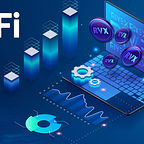Blockchain Revolution in the Healthcare Industry
Introduction
Blockchain technology is a distributed, secure and immutable ledger that provides a highly efficient way to create and trade digital assets. It can be applied to many industries, but healthcare is one of the few sectors where blockchain has already been adopted.Lets take a look at how blockchain can improve health with its key functions.
1. Supply Chain and Drug Traceability
Blockchain can be used to track drugs from the factory to the patient. It’s a distributed ledger that uses a network of computers to record transactions and data. A blockchain comprises blocks, each containing information about previous blocks and linking them together in chronological order (think of it like an onion). This means that multiple copies of this ledger exist across many different computers at once, making it virtually impossible for someone to change anything without being noticed by others across the network.
Blockchain has applications beyond tracking medical devices or other consumer goods; it could also be used for traceability purposes within supply chains; provide proof-of-origin certifications; provide authentication services for pharmaceuticals; help fight counterfeiters by identifying fake drugs before they reach hospitals — the list goes on!
2. Claims Adjudication Data Processing
Blockchain can help with claims adjudication data processing. For example, it can increase efficiency and reduce fraud, improve customer service and data security, and improve the accuracy of data analysis.
3. Care Coordination and Population Management
Blockchain could improve patient outcomes, reduce costs, and improve access to care.
Patients can have a clear understanding of their treatment options by accessing detailed records in one place. This allows for more informed decision-making at all stages of the process — from making an appointment to seeing a doctor or specialist. Patients can also be informed about any changes in their treatment plan as they occur (for example, if they need surgery).
Healthcare providers will benefit from being able to securely share information with each other without having to use expensive third-party systems like EHRs (electronic health records). This means that doctors won’t have access only when they’re physically in one place; instead, doctors will be able to share data across different locations or even countries if necessary!
4. Medical Research Data Sharing
Blockchain technology can help with data sharing. Data sharing is one of the biggest challenges in the medical research world, and blockchain has been identified as a possible solution. The blockchain is a digital ledger that records transactions between parties securely, efficiently and verifiably. This means that it’s not only secure but also transparent: you can see who made an entry on your own copy of the ledger at any time (and vice versa).
It’s important to note how this works because it relates closely to another area where blockchain has already been applied: cryptocurrency trading platforms like ethereum or bitcoin have become popular ways for people around the world who don’t trust each other or governments but still want secure ways of exchanging money online without having their identities exposed or their finances frozen by banks
5. Electronic Health Records (EHRs)
Blockchain can improve the efficiency of EHRs, which are used to store patient data. With blockchain technology, you could use your EHR to share information with other providers in real-time and increase transparency between patients and doctors. For example:
Patients could exchange their medical records with other providers as easily as they would text messages or emails. This would allow them to get better care more quickly without having to wait for insurance approval or another doctor’s approval first. It also means that if someone else needs access to this person’s medical records (e.g., an insurance company), they wouldn’t need any paperwork from the hospital because everything will be automatically recorded on the blockchain itself!
6. Identity Management and Secure Communications
Blockchain technology has the potential to revolutionize identity management and secure communications. The most common use of blockchain technology is in cryptocurrencies like Bitcoin, but it also works with other types of applications.
Blockchain technology can be used for identity management because it allows users to create their own digital identities using pseudonyms or aliases (called “keys”). This means that people don’t need specific passwords or usernames when they access websites or apps on different devices; instead, they just use their key as the username for each device. Users have full control over which keys are associated with them so there isn’t any single point of failure — they can share these keys with friends without worrying about security breaches if someone else gets hold of them accidentally (or worse).
7. Medication Management with the Internet of Things (IoT)
The Internet of Things (IoT) is a network of physical objects or “things” that communicate with each other over the internet. The goal of IoT technology is to allow for more efficient use of resources and enhanced connectivity between devices, people, services and things. Among its key applications are healthcare management systems that involve tracking medication usage and supply chain management for medication distribution within the system; medical device tracking so patients only receive what they need; medical records storage on blockchain networks which ensure security against tampering or loss; research data storage via blockchain networks which ensure privacy while allowing access by only those who need it (e.g., doctors).
Conclusion
In conclusion, blockchain technology has the potential to revolutionize healthcare by providing new tools and solutions to improve practices. However, there are still many barriers that need to be overcome before this happens. Knowledge about blockchain is growing among healthcare professionals, but most don’t have the experience necessary for implementing it in practice yet. This lack of knowledge prevents them from making decisions regarding which applications would be best suited for their needs and patients’ needs as well; thus hindering innovation in the sector
